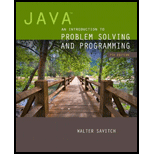
Java: An Introduction to Problem Solving and Programming (7th Edition)
7th Edition
ISBN: 9780133766264
Author: Walter Savitch
Publisher: PEARSON
expand_more
expand_more
format_list_bulleted
Question
Chapter 2, Problem 7PP
Program Plan Intro
Water Well
- • Include the required header files.
- • Declare the global variables.
- • Define main function.
- ○ Declare the required variables.
- ○ Create an object for the scanner.
- ○ Get the radius and deep of the well from the user.
- ○ Calculate the gallons.
- ○ Display the result.
Expert Solution & Answer
Want to see the full answer?
Check out a sample textbook solution
Students have asked these similar questions
Need help making python code for this!
2.7 LAB: Smallest of two numbers
Instructor note:
Note: this section of your textbook contains activities that you will complete for points. To ensure your work is scored, please access this page from the assignment link provided in the CTU Virtual Campus. If you did not access this page via the CTU Virtual Campus, please do so now.
I help understanding this question
d'y + 4dy +3y = a, Initial Conditions: y(0) = 5 & y'(0)=0
Where a = 10
a) Find y(t) =yh(t) +yp(t) in time domainIs the system over-damped, under-damped, or critical?
b) Find y(t) using Laplace Transforms
Chapter 2 Solutions
Java: An Introduction to Problem Solving and Programming (7th Edition)
Ch. 2.1 - Prob. 1STQCh. 2.1 - Can a Java program have two different variables...Ch. 2.1 - Prob. 3STQCh. 2.1 - Give the declaration for two variables of type...Ch. 2.1 - Write the declaration for two variables called...Ch. 2.1 - What is the normal spelling convention for named...Ch. 2.1 - Prob. 7STQCh. 2.1 - Prob. 8STQCh. 2.1 - Prob. 9STQCh. 2.1 - Prob. 10STQ
Ch. 2.1 - Prob. 11STQCh. 2.1 - In the Programming Tip entitled Type Casting a...Ch. 2.1 - What is the output produced by the following lines...Ch. 2.1 - What is the output produced by the following lines...Ch. 2.1 - Prob. 15STQCh. 2.1 - Prob. 16STQCh. 2.1 - Consider the following statement from the program...Ch. 2.1 - Prob. 18STQCh. 2.2 - Prob. 19STQCh. 2.2 - What output is produced by the following...Ch. 2.2 - What output is produced by the following...Ch. 2.2 - What output is produced by the following...Ch. 2.2 - What output is produced by the following...Ch. 2.2 - What output is produced by the following...Ch. 2.2 - What is the value of the expression sl.equals(s2)...Ch. 2.2 - What is the value of the expression s1.equals (s2)...Ch. 2.3 - Write Java statements that will cause the...Ch. 2.3 - What is the difference between the methods...Ch. 2.3 - Write a complete Java program that reads a line of...Ch. 2.3 - Write a complete Java program that reads one line...Ch. 2.3 - What output is produced by the following...Ch. 2.4 - Prob. 32STQCh. 2.4 - What is the output produced by the following Java...Ch. 2.4 - Although it is kind of silly, state legislatures...Ch. 2.5 - Prob. 35STQCh. 2.5 - Give a Java statement that will display a dialog...Ch. 2.5 - Give a Java statement that, when executed, will...Ch. 2.5 - Prob. 38STQCh. 2.5 - Write a complete Java program that produces a...Ch. 2.5 - Write a complete Java program that behaves as...Ch. 2 - Write a program that demonstrates the approximate...Ch. 2 - Write a program that demonstrates type casting of...Ch. 2 - Write a program that demonstrates the operator %...Ch. 2 - If u = 2, v = 3, w = 5, x = 7, and y = 11, what is...Ch. 2 - What changes to the ChangeMaker program in Listing...Ch. 2 - If the int variable x contains 10, what will the...Ch. 2 - Write some Java statements that use the String...Ch. 2 - Prob. 8ECh. 2 - Prob. 9ECh. 2 - Write a single Java statement that will display...Ch. 2 - What does the Java code Scanner keyboard = new...Ch. 2 - What does the Java code Scanner keyboard = new...Ch. 2 - Prob. 13ECh. 2 - Many sports have constants embedded in their...Ch. 2 - Prob. 15ECh. 2 - Define named constants that you could use in...Ch. 2 - Write a program that reads three whole numbers and...Ch. 2 - Write a program that uses Scanner to read two...Ch. 2 - Write a program that reads the amount of a monthly...Ch. 2 - Write a program that reads a four-digit integer,...Ch. 2 - Prob. 5PCh. 2 - Prob. 6PCh. 2 - Write a program that converts degrees from...Ch. 2 - Write a program that reads a line of text and then...Ch. 2 - Write a program that will read a line of text as...Ch. 2 - Write a program that asks the user to enter a...Ch. 2 - Write a program that determines the change to be...Ch. 2 - Write a program that reads a 4-bit binary number...Ch. 2 - Prob. 7PPCh. 2 - The Harris-Benedict equation estimates the number...Ch. 2 - Repeat any of the previous programming projects...Ch. 2 - Write a program that reads a string for a date in...Ch. 2 - It is important to consider the effect of thermal...
Knowledge Booster
Similar questions
- Given f(t)=a sin(ßt) a = 10 & ß = 23 Find the Laplace Transform using the definition F(s) = ∫f(t)e-stdtarrow_forwardPlease do not use any AI tools to solve this question. I need a fully manual, step-by-step solution with clear explanations, as if it were done by a human tutor. No AI-generated responses, please.arrow_forwardObtain the MUX design for the function F(X,Y,Z) = (0,3,4,7) using an off-the-shelf MUX with an active low strobe input (E).arrow_forward
- I cannot program smart home automation rules from my device using a computer or phone, and I would like to know how to properly connect devices such as switches and sensors together ? Cisco Packet Tracer 1. Smart Home Automation:o Connect a temperature sensor and a fan to a home gateway.o Configure the home gateway so that the fan is activated when the temperature exceedsa set threshold (e.g., 30°C).2. WiFi Network Configuration:o Set up a wireless LAN with a unique SSID.o Enable WPA2 encryption to secure the WiFi network.o Implement MAC address filtering to allow only specific clients to connect.3. WLC Configuration:o Deploy at least two wireless access points connected to a Wireless LAN Controller(WLC).o Configure the WLC to manage the APs, broadcast the configured SSID, and applyconsistent security settings across all APs.arrow_forwardusing r language for integration theta = integral 0 to infinity (x^4)*e^(-x^2)/2 dx (1) use the density function of standard normal distribution N(0,1) f(x) = 1/sqrt(2pi) * e^(-x^2)/2 -infinity <x<infinity as importance function and obtain an estimate theta 1 for theta set m=100 for the estimate whatt is the estimate theta 1? (2)use the density function of gamma (r=5 λ=1/2)distribution f(x)=λ^r/Γ(r) x^(r-1)e^(-λx) x>=0 as importance function and obtain an estimate theta 2 for theta set m=1000 fir the estimate what is the estimate theta2? (3) use simulation (repeat 1000 times) to estimate the variance of the estimates theta1 and theta 2 which one has smaller variance?arrow_forwardusing r language A continuous random variable X has density function f(x)=1/56(3x^2+4x^3+5x^4).0<=x<=2 (1) secify the density g of the random variable Y you find for the acceptance rejection method. (2) what is the value of c you choose to use for the acceptance rejection method (3) use the acceptance rejection method to generate a random sample of size 1000 from the distribution of X .graph the density histogram of the sample and compare it with the density function f(x)arrow_forward
- using r language a continuous random variable X has density function f(x)=1/4x^3e^-(pi/2)^4,x>=0 derive the probability inverse transformation F^(-1)x where F(x) is the cdf of the random variable Xarrow_forwardusing r language in an accelerated failure test, components are operated under extreme conditions so that a substantial number will fail in a rather short time. in such a test involving two types of microships 600 chips manufactured by an existing process were tested and 125 of them failed then 800 chips manufactured by a new process were tested and 130 of them failed what is the 90%confidence interval for the difference between the proportions of failure for chips manufactured by two processes? using r languagearrow_forwardI want a picture of the tools and the pictures used Cisco Packet Tracer Smart Home Automation:o Connect a temperature sensor and a fan to a home gateway.o Configure the home gateway so that the fan is activated when the temperature exceedsa set threshold (e.g., 30°C).2. WiFi Network Configuration:o Set up a wireless LAN with a unique SSID.o Enable WPA2 encryption to secure the WiFi network.o Implement MAC address filtering to allow only specific clients to connect.3. WLC Configuration:o Deploy at least two wireless access points connected to a Wireless LAN Controller(WLC).o Configure the WLC to manage the APs, broadcast the configured SSID, and applyconsistent security settings across all APs.arrow_forward
- A. What will be printed executing the code above?B. What is the simplest way to set a variable of the class Full_Date to January 26 2020?C. Are there any empty constructors in this class Full_Date?a. If there is(are) in which code line(s)?b. If there is not, how would an empty constructor be? (create the code lines for it)D. Can the command std::cout << d1.m << std::endl; be included after line 28 withoutcausing an error?a. If it can, what will be printed?b. If it cannot, how could this command be fixed?arrow_forwardCisco Packet Tracer Smart Home Automation:o Connect a temperature sensor and a fan to a home gateway.o Configure the home gateway so that the fan is activated when the temperature exceedsa set threshold (e.g., 30°C).2. WiFi Network Configuration:o Set up a wireless LAN with a unique SSID.o Enable WPA2 encryption to secure the WiFi network.o Implement MAC address filtering to allow only specific clients to connect.3. WLC Configuration:o Deploy at least two wireless access points connected to a Wireless LAN Controller(WLC).o Configure the WLC to manage the APs, broadcast the configured SSID, and applyconsistent security settings across all APs.arrow_forwardTransform the TM below that accepts words over the alphabet Σ= {a, b} with an even number of a's and b's in order that the output tape head is positioned over the first letter of the input, if the word is accepted, and all letters a should be replaced by the letter x. For example, for the input aabbaa the tape and head at the end should be: [x]xbbxx z/z,R b/b,R F ① a/a,R b/b,R a/a, R a/a,R b/b.R K a/a,R L b/b,Rarrow_forward
arrow_back_ios
SEE MORE QUESTIONS
arrow_forward_ios
Recommended textbooks for you
 C++ for Engineers and ScientistsComputer ScienceISBN:9781133187844Author:Bronson, Gary J.Publisher:Course Technology Ptr
C++ for Engineers and ScientistsComputer ScienceISBN:9781133187844Author:Bronson, Gary J.Publisher:Course Technology Ptr C++ Programming: From Problem Analysis to Program...Computer ScienceISBN:9781337102087Author:D. S. MalikPublisher:Cengage Learning
C++ Programming: From Problem Analysis to Program...Computer ScienceISBN:9781337102087Author:D. S. MalikPublisher:Cengage Learning Operations Research : Applications and AlgorithmsComputer ScienceISBN:9780534380588Author:Wayne L. WinstonPublisher:Brooks Cole
Operations Research : Applications and AlgorithmsComputer ScienceISBN:9780534380588Author:Wayne L. WinstonPublisher:Brooks Cole Principles of Information Systems (MindTap Course...Computer ScienceISBN:9781285867168Author:Ralph Stair, George ReynoldsPublisher:Cengage Learning
Principles of Information Systems (MindTap Course...Computer ScienceISBN:9781285867168Author:Ralph Stair, George ReynoldsPublisher:Cengage Learning A+ Guide to Hardware (Standalone Book) (MindTap C...Computer ScienceISBN:9781305266452Author:Jean AndrewsPublisher:Cengage Learning
A+ Guide to Hardware (Standalone Book) (MindTap C...Computer ScienceISBN:9781305266452Author:Jean AndrewsPublisher:Cengage Learning A+ Guide To It Technical SupportComputer ScienceISBN:9780357108291Author:ANDREWS, Jean.Publisher:Cengage,
A+ Guide To It Technical SupportComputer ScienceISBN:9780357108291Author:ANDREWS, Jean.Publisher:Cengage,

C++ for Engineers and Scientists
Computer Science
ISBN:9781133187844
Author:Bronson, Gary J.
Publisher:Course Technology Ptr

C++ Programming: From Problem Analysis to Program...
Computer Science
ISBN:9781337102087
Author:D. S. Malik
Publisher:Cengage Learning

Operations Research : Applications and Algorithms
Computer Science
ISBN:9780534380588
Author:Wayne L. Winston
Publisher:Brooks Cole

Principles of Information Systems (MindTap Course...
Computer Science
ISBN:9781285867168
Author:Ralph Stair, George Reynolds
Publisher:Cengage Learning

A+ Guide to Hardware (Standalone Book) (MindTap C...
Computer Science
ISBN:9781305266452
Author:Jean Andrews
Publisher:Cengage Learning

A+ Guide To It Technical Support
Computer Science
ISBN:9780357108291
Author:ANDREWS, Jean.
Publisher:Cengage,